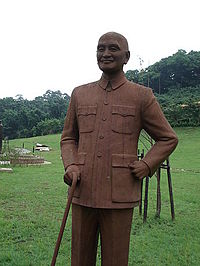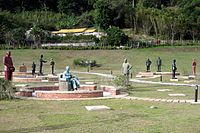- Chiang Kai-shek statues
-
A Chiang Kai-shek statue (蔣公銅像) are statues of the late Republic of China (ROC) President Chiang Kai-shek. They are found almost everywhere in Taiwan, from parks to schools to military bases, and are usually made of an bronze alloy, although it varies from location to location.[1]
Contents
History
President Chiang Kai-shek led the Republic of China and the Kuomintang (KMT). Once controlling all of China, he lost Mainland China to the Chinese Communists following the temporary cessation of the Chinese Civil War. He retreated to Taiwan with the ROC government and vowed to one day re-take the Mainland.[2]
Partial removal
In February 2007, the Republic of China government, under the Taiwan independence-minded DPP Chen Shui-bian administration, decided to remove these statues from military premises. The ruling Democratic Progressive Party claimed that they represented Chiang Kai-shek's authoritarian rule and were not in-line with a representative democracy. Opposition party Kuomintang (KMT), on the other hand, opposed the removal of the statues, claiming that the DPP was attempting to cut off Taiwan's Chinese heritage, and distort history.[3] On 2007-03-10, the KMT expelled Defense Minister Lee Jye from the party for removing the statues as ordered by the government. The party cited that Lee's actions damaged the party's image. Lee has said that he regretted the party's decision for expulsion, but that he had no plans to join the DPP.[4][5] The removal of the second biggest seated bronze statue from the city of Kaohsiung's Chiang Kai-shek Cultural Center prompted clashes between protestors who are against the removal, and the police, who were sent to secure the site while the city workers dismantled the statue.[6][7]
The Chiang Kai-shek Cultural Center statue was later transported to Cihu, Daxi in Taoyuan County. Originally, the statue was supposed to be split into 8 parts, but the Daxi government received 200 dismantled parts. It is yet to be seen if the statue can be put back together. The local Daxi government has gladly accepted all Chiang Kai-shek statues in recent years. A special park, located at 24°50′29″N 121°17′38″E / 24.8415°N 121.2940°E, and known among expat residents as the 'Garden of the Generalissimos', is their final resting place.
On 2007-03-15, the mayor of Daxi, Su Wen-sheng, left for Xikou, Zhejiang, in the People's Republic of China, to ask the mayor of Xikou if he would accept the statue. As of 2007-03-15, the deputy director of the Taiwan Affairs Office of Zhejiang Province, Shao Jiangwei, had stated that the offer is being considered.[8]
Although there is much news about the removal of Chiang statues, the actual number has been only limited to a handful, considering the amount erected. A few high profile statues have been removed, such as the one located at the Chiang Kai-shek Cultural Center. However, there are still many Chiang statues remaining in Taiwan, where they continue to watch over public squares, schools, and parks.
Gallery
See also
- National Chiang Kai-shek Memorial Hall
- Chiang Kai-shek
- Chiang Kai-shek Memorial Song
- Sun Yat-sen
- List of statues of Lenin
- List of statues of Stalin
References
- ^ Taylor, Jeremy E., (2006). The Production of the Chiang Kai-shek Personality Cult, 1929–1975. The China Quarterly, 185, 96-110. doi:10.1017/S0305741006000063
- ^ "Chiang Kai-shek's legacy attracts respectful Chinese tourists to Taiwanese park". Associated Press. 2007-03-17. http://www.taiwannews.com.tw/etn/news_content.php?id=409881&lang=eng_news&cate_img=49.jpg&cate_rss=news_Society_TAIWAN. Retrieved 2007-03-17.
- ^ "Taiwan statue removal fuels spat". BBC News. 2007-02-06. http://news.bbc.co.uk/2/hi/asia-pacific/6336237.stm. Retrieved 2007-03-11.
- ^ "KMT expels Lee Jye for obeying DPP". Taipei Times. 2007-03-10. http://www.taipeitimes.com/News/front/archives/2007/03/10/2003351657. Retrieved 2007-03-16.
- ^ "Taiwanese party expels minister". BBC News. 2007-03-10. http://news.bbc.co.uk/2/hi/asia-pacific/6436937.stm. Retrieved 2007-03-11.
- ^ "KMT, DPP at odds over Kaohsiung's CKS center". Taipei Times. 2007-03-15. http://www.taipeitimes.com/News/taiwan/archives/2007/03/15/2003352336. Retrieved 2007-03-16.
- ^ "Taiwan furore over statue removal". BBC News. 2007-03-14. http://news.bbc.co.uk/2/hi/asia-pacific/6451261.stm. Retrieved 2007-03-14.
- ^ "Xikou likely to accept Chiang Kai-shek's statue". The China Post. 2007-03-15. http://www.chinapost.com.tw/news/archives/front/2007315/104654.htm. Retrieved 2007-03-16.
External links
- "DPP Criticized as 'Tampering with History'". Taiwan Security Research. 2007-02-07. http://taiwansecurity.org/TN/2007/TN-070207.htm. Retrieved 2007-03-16.[dead link]
- "Chiang Kai-shek statues removed". The Manila Times. 2007-02-08. http://www.manilatimes.net/national/2007/feb/08/yehey/opinion/20070208opi8.html. Retrieved 2007-03-16.[dead link]
Categories:- Buildings and structures in Taiwan
- Chiang Kai-shek
Wikimedia Foundation. 2010.






